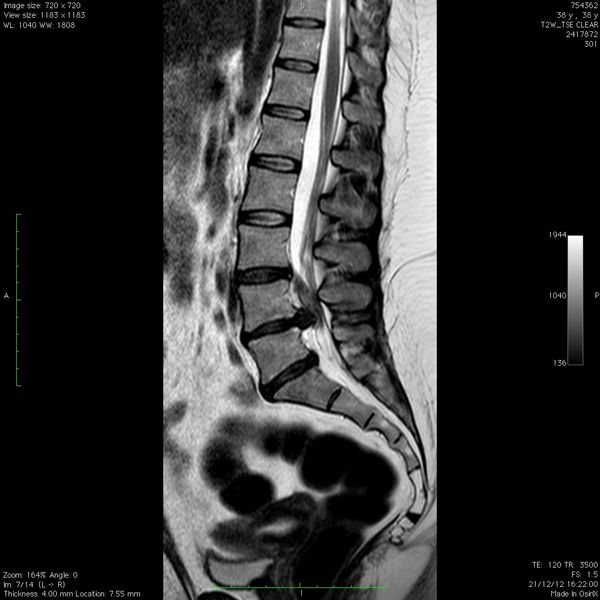Lumbar discal hernia is one of the most common causes of pain in the lumbar region.
Lumbar spine

Lumbar Discal Hernia
The lumbar spine is undoubtedly the area of the spine where the greatest number of neurosurgical pathologies occurred. This can be easily explained by mechanical factors, it is the region that bears the greatest weight of the trunk and upper limbs and, unlike the spinal column, has great mobility.
We will define some of the most frequent clinical syndromes and analyse the different therapeutic options in each case.
This section includes recommendations for postural hygiene and rehabilitation exercises that can be done at home to favour toning up back and spinal muscles.
Lumbar discal hernia occurs when there is a displacement of the intervertebral disc, this displacement will condition a compression of the nerve roots passing through the spinal canal and give rise to a profile of pain irradiated down the leg and known as sciatica.
The aetiopathogenesis of this pathology includes a degenerative component and a traumatic component and so onset of the pathology usually begins following considerable physical force.
Diagnosis of lumbar discal hernia:
After a physical examination, imaging tests, including magnetic resonance imaging, will provide more information about the level of affectation and the amount of degeneration of the disc and adjacent vertebrae.
In certain cases functional tests will be required to better assess the stability of the lumbar spine.
Treatment of lumbar discal hernia:
After onset of sciatica, the first 2-3 days require absolute bed rest, associated with antiinflammatory and analgesic treatments. After this period begin with progressive movement. In those cases where the pain does not respond to rest and analgesia, patients with neurological deficits as well as patients with recurrent episodes of sciatica, surgery will be the treatment of choice.
Surgery should not be delayed in patients with neurological deficits secondary to lumbar discal hernia as the prognosis is related to the time of progress of these deficiencies.
There are various types of surgical procedures and only a correct diagnosis by the neurosurgeon will enable applying the most indicated treatment in each case. These procedures include:
- Percutaneous discolysis: a substance is injected into the disc to reduce its volume and the pressure it exerts on nerve structures.
- Endoscopic discectomy: especially indicated for contained, non-migrated hernias as it represents less aggression on tissues in comparison to the classic discectomy.
- Microdiscectomy: especially indicated in cases of migrated hernias. There are a large number of variations of this surgical technique all designed to minimise surgical aggression on surrounding tissues.
Recommendations following surgery for lumbar discal hernia
Once the lumbar discal hernia surgery is completed, whether discectomy, laminectomy or spinal fixation, the spine will remain stable even though it has been sunjected to a surgical operation and therefore it will require a period of convalescence before strenuous physical exercise.
In general our patients are recommended to ensure relative rest for 15 days. This implies short walks in the street, less than 10 minutes the first week and from 15-20 minutes the second week, and above all avoiding postures that apply additional load on the back. In successive weeks they should progressively increase the activity and be walking for 45 minutes after 2 months.
The patient can usually reinitiate daily activities at 3-4 weeks in the event of discectomy and laminectomy, this being somewhat more prolonged, 6-12 weeks, in cases where lumbar instrumentation has been performed.



